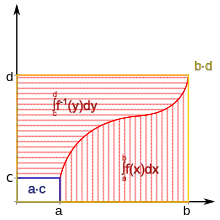Integral of inverse functions
In mathematics, integrals of inverse functions can be computed by means of a formula that expresses the antiderivatives of the inverse of a continuous and invertible function , in terms of and an antiderivative of . This formula was published in 1905 by Charles-Ange Laisant.[1]
| Part of a series of articles about |
| Calculus |
|---|
Statement of the theorem
Let and be two intervals of . Assume that is a continuous and invertible function. It follows from the intermediate value theorem that is strictly monotone. Consequently, maps intervals to intervals, so is an open map and thus a homeomorphism. Since and the inverse function are continuous, they have antiderivatives by the fundamental theorem of calculus.
Laisant proved that if is an antiderivative of , then the antiderivatives of are:
where is an arbitrary real number. Note that it is not assumed that is differentiable.

In his 1905 article, Laisant gave three proofs. First, under the additional hypothesis that is differentiable, one may differentiate the above formula, which completes the proof immediately. His second proof was geometric. If and , the theorem can be written:
The figure on the right is a proof without words of this formula. Laisant does not discuss the hypotheses necessary to make this proof rigorous, but this can be proved if is just assumed to be strictly monotone (but not necessarily continuous, let alone differentiable). In this case, both and are Riemann integrable and the identity follows from a bijection between lower/upper Darboux sums of and upper/lower Darboux sums of .[2][3] The antiderivative version of the theorem then follows from the fundamental theorem of calculus in the case when is also assumed to be continuous. Laisant's third proof uses the additional hypothesis that is differentiable. Beginning with , one multiplies by and integrates both sides. The right-hand side is calculated using integration by parts to be , and the formula follows.
Nevertheless, it can be shown that this theorem holds even if or is not differentiable:[3][4] it suffices, for example, to use the Stieltjes integral in the previous argument. On the other hand, even though general monotonic functions are differentiable almost everywhere, the proof of the general formula does not follow, unless is absolutely continuous.[4]
It is also possible to check that for every in , the derivative of the function is equal to . In other words:
To this end, it suffices to apply the mean value theorem to between and , taking into account that is monotonic.
Examples
- Assume that , hence . The formula above gives immediately
- Similarly, with and ,
- With and ,
History
Apparently, this theorem of integration was discovered for the first time in 1905 by Charles-Ange Laisant,[1] who "could hardly believe that this theorem is new", and hoped its use would henceforth spread out among students and teachers. This result was published independently in 1912 by an Italian engineer, Alberto Caprilli, in an opuscule entitled "Nuove formole d'integrazione".[5] It was rediscovered in 1955 by Parker,[6] and by a number of mathematicians following him.[7] Nevertheless, they all assume that f or f−1 is differentiable. The general version of the theorem, free from this additional assumption, was proposed by Michael Spivak in 1965, as an exercise in the Calculus,[2] and a fairly complete proof following the same lines was published by Eric Key in 1994.[3] This proof relies on the very definition of the Darboux integral, and consists in showing that the upper Darboux sums of the function f are in 1-1 correspondence with the lower Darboux sums of f−1. In 2013, Michael Bensimhoun, estimating that the general theorem was still insufficiently known, gave two other proofs:[4] The second proof, based on the Stieltjes integral and on its formulae of integration by parts and of homeomorphic change of variables, is the most suitable to establish more complex formulae.
Generalization to holomorphic functions
The above theorem generalizes in the obvious way to holomorphic functions: Let and be two open and simply connected sets of , and assume that is a biholomorphism. Then and have antiderivatives, and if is an antiderivative of , the general antiderivative of is
Because all holomorphic functions are differentiable, the proof is immediate by complex differentiation.
References
- Laisant, C.-A. (1905). "Intégration des fonctions inverses". Nouvelles annales de mathématiques, journal des candidats aux écoles polytechnique et normale. 5 (4): 253–257.
- Michael Spivak, Calculus (1967), chap. 13, pp. 235.
- Key, E. (Mar 1994). "Disks, Shells, and Integrals of Inverse Functions". The College Mathematics Journal. 25 (2): 136–138. doi:10.2307/2687137. JSTOR 2687137.
- Bensimhoun, Michael (2013). "On the antiderivative of inverse functions". arXiv:1312.3839 [math.HO].
- Read online
- Parker, F. D. (Jun–Jul 1955). "Integrals of inverse functions". The American Mathematical Monthly. 62 (6): 439–440. doi:10.2307/2307006. JSTOR 2307006.
- It is equally possible that some or all of them simply recalled this result in their paper, without referring to previous authors.
- Staib, J. H. (Sep 1966). "The Integration of Inverse Functions". Mathematics Magazine. 39 (4): 223–224. doi:10.2307/2688087. JSTOR 2688087.